Page 74 of 380
�µ
The ignition switch is on the right
side of the steering column. It has
f our positions:
LOCK(0)
ACCESSORY (I)
ON (II)
START (III) If the f ront wheels are turned, the
anti-thef t lock may sometimes make
it difficult to turn the key from
LOCK to ACCESSORY. Firmly turn
the steering wheel to the lef t or to
the right as you turn the key.You can insert or
remove the key only in this position.
To switch f rom ACCESSORY to
LOCK, you must push the key in
slightly as you turn it. If your car has
an automatic transmission, the shif t
lever must also be in Park. The anti-
thef t lock will lock the steering
column when you remove the key.
CONT INUED
Ignition Switch L OCK (0)
Keys and Locks
Inst rument s and Cont rols77
Removing the key from the
ignition switch while driving
locks the steering. This can
cause you to lose control.
Remove the key from the
ignition switch only whenparked.
�����—�����—�����y���������������y���
�(�����������y���������y
Page 188 of 380
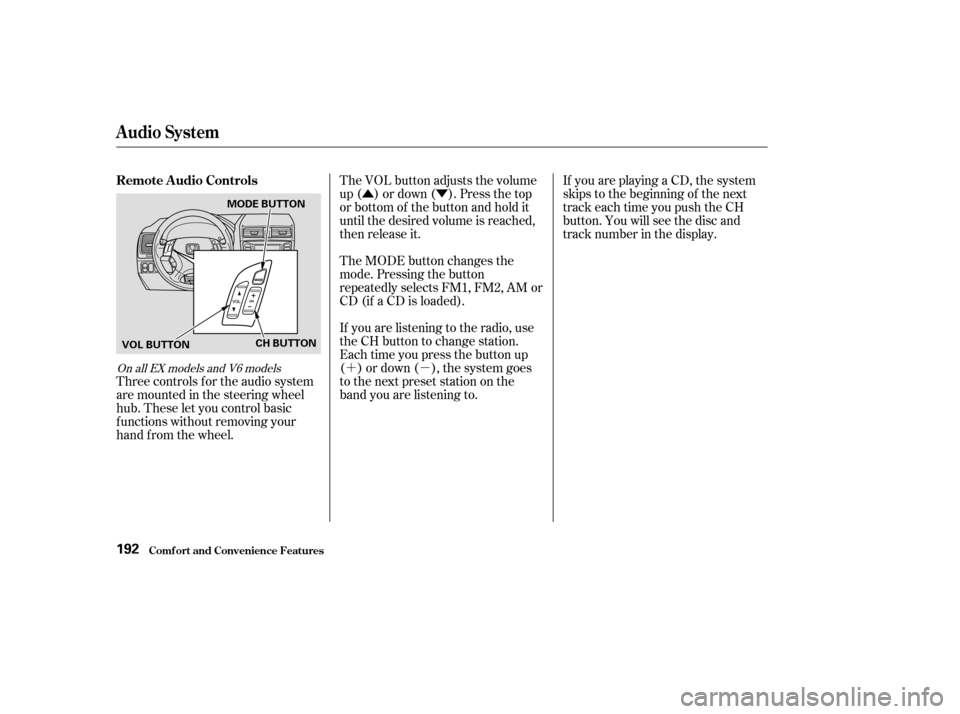
�Û�Ý
�´�µ
Three controls f or the audio system
are mounted in the steering wheel
hub. These let you control basic
f unctions without removing your
hand f rom the wheel. The VOL button adjusts the volume
up ( ) or down ( ). Press the top
or bottom of the button and hold it
until the desired volume is reached,
then release it.
If youareplayingaCD,thesystem
skips to the beginning of the next
track each time you push the CH
button. You will see the disc and
track number in the display.
The MODE button changes the
mode. Pressing the button
repeatedly selects FM1, FM2, AM or
CD (if a CD is loaded).
If you are listening to the radio, use
the CH button to change station.
Each time you press the button up
()ordown(),thesystemgoes
to the next preset station on the
band you are listening to.
On all EX models and V6 models
Remote Audio Controls
Audio System
Comf ort and Convenience Feat ures192
CH BUTTON
VOL BUTTON MODE BUTTON
�����—�����—�����y������
����
���y���
�(�����������y���
�����y
Page 191 of 380
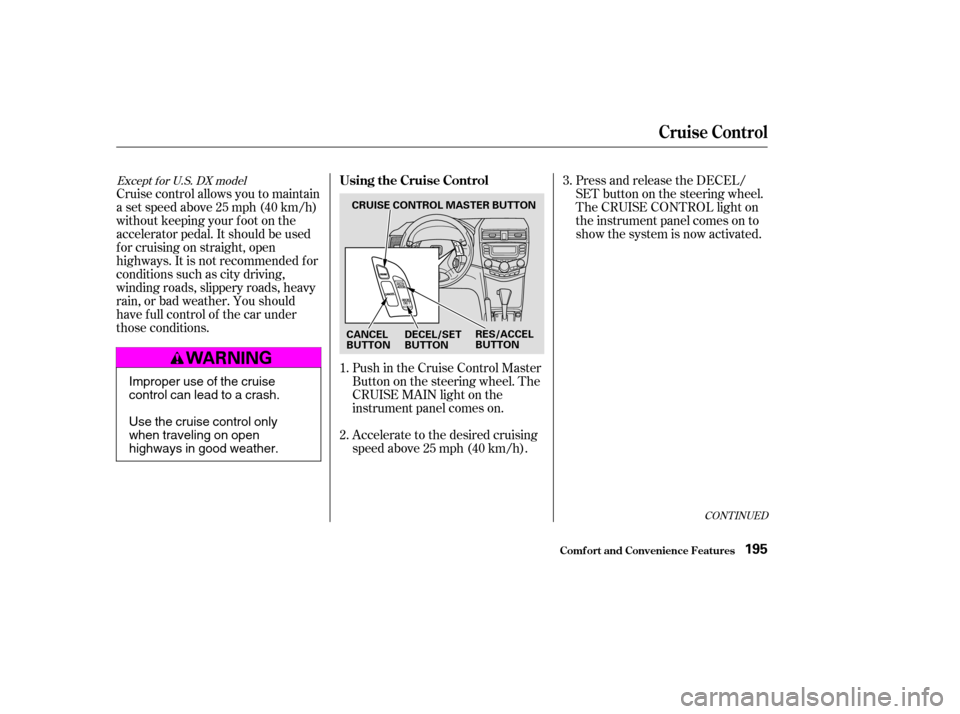
Accelerate to the desired cruising
speedabove25mph(40km/h).
Push in the Cruise Control Master
Buttononthesteeringwheel.The
CRUISE MAIN light on the
instrument panel comes on. Press and release the DECEL/
SET button on the steering wheel.
The CRUISE CONTROL light on
the instrument panel comes on to
show the system is now activated.
Cruise control allows you to maintain
asetspeedabove25mph(40km/h)
without keeping your f oot on the
accelerator pedal. It should be used
f or cruising on straight, open
highways. It is not recommended f or
conditions such as city driving,
winding roads, slippery roads, heavy
rain, or bad weather. You should
have f ull control of the car under
those conditions.
1. 2.3.
CONT INUED
Except f or U.S. DX modelUsing the Cruise Control
Cruise Control
Comf ort and Convenience Feat ures195
CRUISE CONTROL MASTER BUTTON
CANCEL
BUTTON RES/ACCEL
BUTTON
DECEL/SET
BUTTON
Improper use of the cruise
control can lead to a crash.
Use the cruise control only
when traveling on open
highways in good weather.
�����—�����—�����y������
��������y���
�(�����������y���
�����y
Page 193 of 380
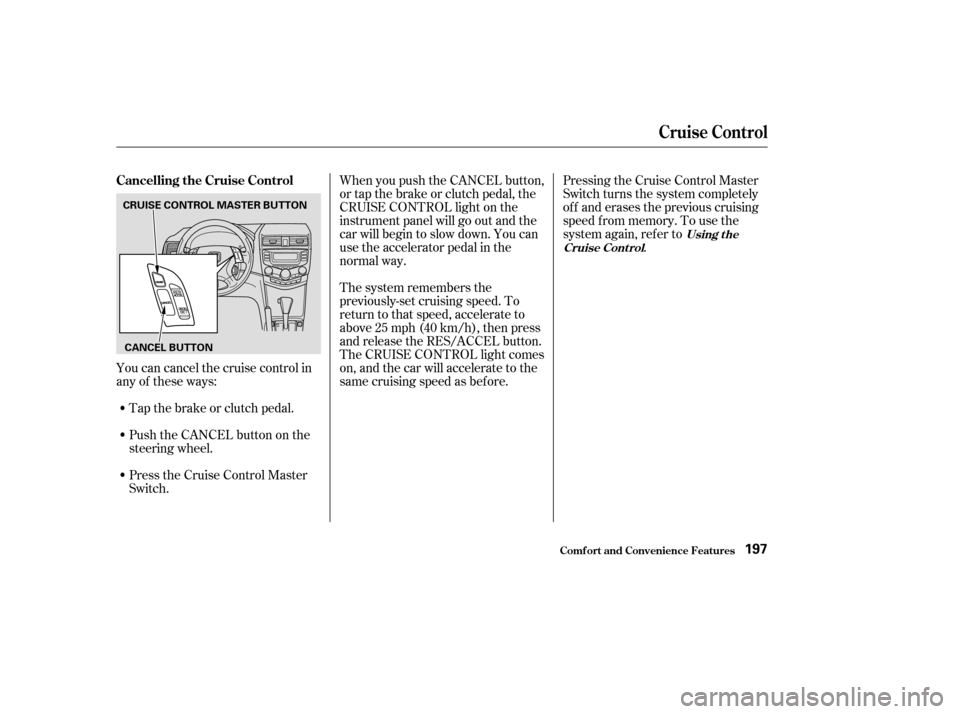
Pressing the Cruise Control Master
Switch turns the system completely
of f and erases the previous cruising
speed f rom memory. To use the
system again, ref er to.
Press the Cruise Control Master
Switch.
Push the CANCEL button on the
steering wheel.
Tap the brake or clutch pedal.
Youcancancelthecruisecontrolin
any of these ways: When you push the CANCEL button,
or tap the brake or clutch pedal, the
CRUISE CONTROL light on the
instrument panel will go out and the
car will begin to slow down. You can
use the accelerator pedal in the
normal way.
The system remembers the
previously-set cruising speed. To
return to that speed, accelerate to
above25mph(40km/h),thenpress
and release the RES/ACCEL button.
The CRUISE CONTROL light comes
on, and the car will accelerate to the
same cruising speed as bef ore.
Using t he
Cruise Cont rol
Cancelling the Cruise Control
Cruise Control
Comf ort and Convenience Feat ures197
CANCEL BUTTON
CRUISE CONTROL MASTER BUTTON
�����—�����—�����y���������������y���
�(�����������y���������y
Page 208 of 380

In addition, any modif ications that
decrease ground clearance increase
the chance of undercarriage parts
striking a curb, speed bump, or other
raised object, which could cause
your airbags to deploy.
Do not modif y your steering wheel
or any other part of your
Supplemental Restraint System.
Modif ications could make the
system inef f ective.
Do not remove any original
equipment or modif y your car in any
way that would alter its design or
operation. This could make your car
unsaf e and illegal to drive.
For example, do not make any
modif ications that would change the
ride height of your car, or install
wheels and tires with a dif f erent
overall diameter.
Such modif ications can adversely
af f ect handling, and interf ere with
the operation of the car’s anti-lock
brakes and other systems.
Any object
attached to or placed on the covers
marked ‘‘SRS AIRBAG,’’ in the
center of the steering wheel and
on top of the dashboard, could
interf ere with the proper operation
of the airbags. Or, if the airbags
inf late, the objects could be
propelled inside the car and hurt
someone. If a side airbag
or a side curtain airbag inf lates, a
cupholderorotherhardobject
attached on or near the door could
be propelled inside the car and
hurt someone.
Covering the outside edge of a
f ront seat-back, with a non-Honda
seat cover for example, could
prevent the airbag from inflating
properly.On models equipped with side airbags or
side curtain airbagsModif ications
Additional Saf ety Precautions
A ccessories and Modif ications
Bef ore Driving
Do not at t ach or place object s onthe f ront airbag covers. Do not at t ach hard object s on or
near a f ront door.
Do not place any object s over t heoutsideedgeof afront seat-back.
213
�����—�����—�����y���������������y���
�(�����������y�����
���y
Page 212 of 380

Make sure all windows, mirrors,
and outside lights are clean and
unobstructed. Remove f rost, snow,
or ice.
Check that the hood and trunk are
f ully closed.Check the adjustment of the seat
(see page ).
Check the adjustment of the
inside and outside mirrors (see
page ).
Check the adjustment of the
steering wheel (see page ).
Make sure the doors are securely
closed and locked.
Fasten your seat belt. Check that
your passengers have f astened
their seat belts (see page ).Turn the ignition switch ON (II).
Check the indicator lights in the
instrument panel.
Start the engine (see page ).
Check the gauges and indicator
lights in the instrument panel (see
page ).
Check that any items you may be
carrying with you inside are stored
properly or f astened down
securely.
Visually check the tires. If a tire
looks low, use a gauge to check its
pressure.
Youshoulddothefollowingchecks
and adjustments every day bef ore
you drive your car.
3.2.
1.
4. 5.
6. 7. 8. 9. 11.
12. 10.
15
87
219
57
101
73
Preparing to Drive
Driving218
�����—�����—�����y���������������y���
�(�����������y�������
�y
Page 224 of 380
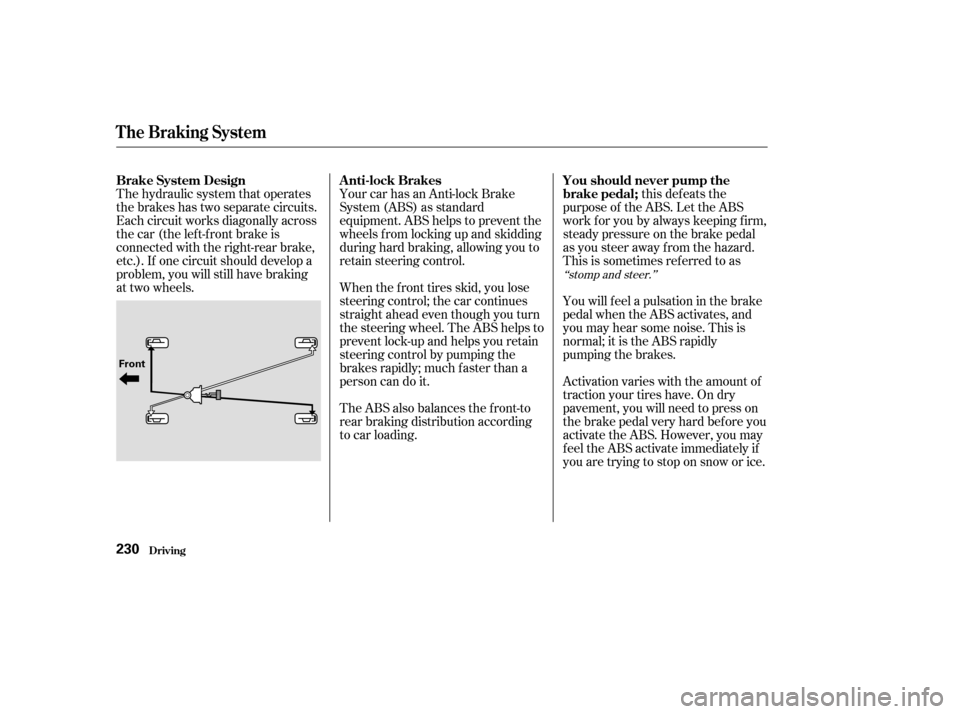
this defeats the
purpose of the ABS. Let the ABS
work f or you by always keeping f irm,
steady pressure on the brake pedal
as you steer away from the hazard.
This is sometimes ref erred to as
You will f eel a pulsation in the brake
pedal when the ABS activates, and
you may hear some noise. This is
normal; it is the ABS rapidly
pumping the brakes.
Activation varies with the amount of
traction your tires have. On dry
pavement, you will need to press on
thebrakepedalveryhardbeforeyou
activate the ABS. However, you may
feel the ABS activate immediately if
you are trying to stop on snow or ice.
The hydraulic system that operates
the brakes has two separate circuits.
Each circuit works diagonally across
the car (the lef t-f ront brake is
connected with the right-rear brake,
etc.). If one circuit should develop a
problem, you will still have braking
at two wheels.
Your car has an Anti-lock Brake
System (ABS) as standard
equipment. ABS helps to prevent the
wheels f rom locking up and skidding
during hard braking, allowing you to
retain steering control.
When the f ront tires skid, you lose
steering control; the car continues
straightaheadeventhoughyouturn
the steering wheel. The ABS helps to
prevent lock-up and helps you retain
steering control by pumping the
brakes rapidly; much f aster than a
person can do it.
The ABS also balances the f ront-to
rear braking distribution according
to car loading.
‘‘stomp and steer.’’
A nti-lock Brakes You should never pump the
brake pedal;
Brake System Design
The Braking System
Driving230
Front
�����—�����—�����y�����������
���y���
�(�����������y���������y
Page 225 of 380
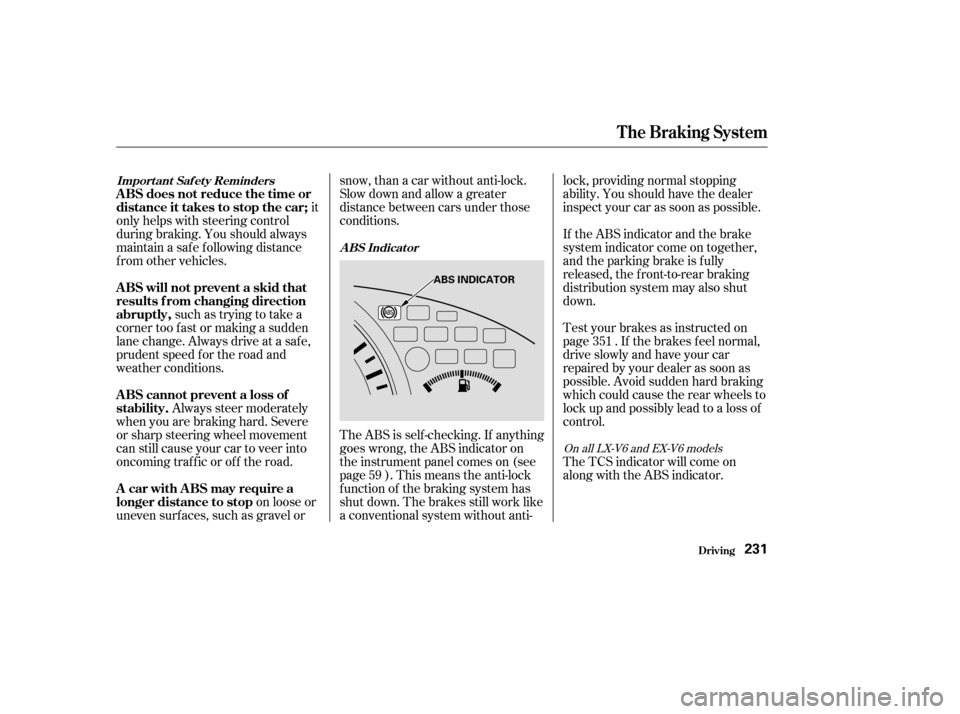
such as trying to take a
corner too f ast or making a sudden
lane change. Always drive at a safe,
prudent speed f or the road and
weather conditions.
Always steer moderately
when you are braking hard. Severe
or sharp steering wheel movement
can still cause your car to veer into
oncoming traffic or off the road. it
only helps with steering control
during braking. You should always
maintain a saf e f ollowing distance
f rom other vehicles.
The ABS is self -checking. If anything
goes wrong, the ABS indicator on
the instrument panel comes on (see
page ). This means the anti-lock
f unction of the braking system has
shut down. The brakes still work like
a conventional system without anti-lock, providing normal stopping
ability. You should have the dealer
inspect your car as soon as possible.
on loose or
uneven surf aces, such as gravel or snow, than a car without anti-lock.
Slow down and allow a greater
distance between cars under those
conditions.
If the ABS indicator and the brake
system indicator come on together,
and the parking brake is f ully
released, the front-to-rear braking
distribution system may also shut
down.
Test your brakes as instructed on
page . If the brakes f eel normal,
drive slowly and have your car
repaired by your dealer as soon as
possible. Avoid sudden hard braking
which could cause the rear wheels to
lock up and possibly lead to a loss of
control.
The TCS indicator will come on
alongwiththeABSindicator.
59 351
On all LX-V6 and EX-V6 models
Import ant Saf et y Reminders
A BS Indicat or
A BS will not prevent a skid that
results f rom changing direction
abruptly,
A BS cannot prevent a loss of
stability.
A BS does not reduce the time or
distance it takes to stop the car;
A car with ABS may require a
longer distance to stop
The Braking System
Driving231
ABS INDICATOR
�����—�����—�����y���������������y���
�(�����������y���������y